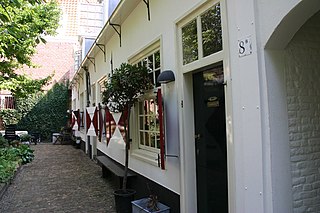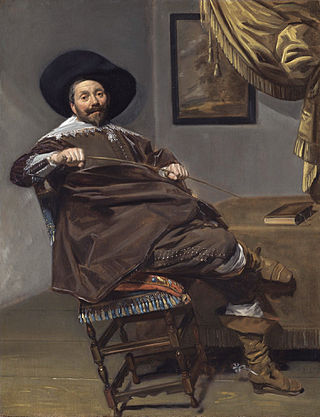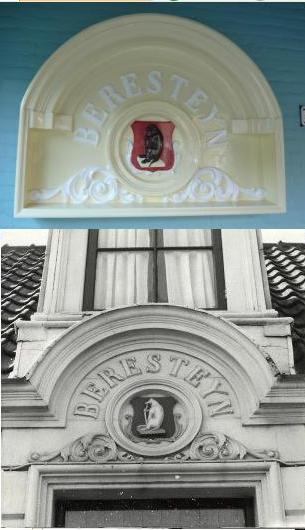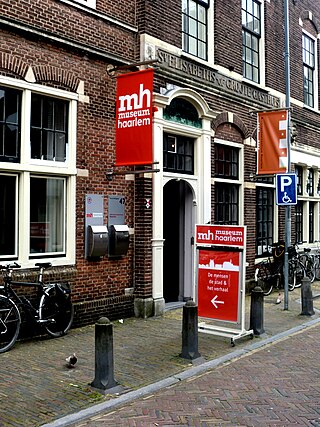
Frans Hals the Elder was a Dutch Golden Age painter. He lived and worked in Haarlem, a city in which the local authority of the day frowned on religious painting in places of worship but citizens liked to decorate their homes with works of art. Hals was highly sought after by wealthy burgher commissioners of individual, married-couple, family, and institutional-group portraits. He also painted tronies for the general market.

The Frans Hals Museum is a museum in the North Holland city of Haarlem, the Netherlands, founded in 1862, known as the Art Museum of Haarlem. Its collection is based on the city's own rich collection, built up from the 16th century onwards. The museum owns hundreds of paintings, including more than a dozen by Frans Hals, to whom the museum owes its name. The Frans Hals Museum has two historic locations in Haarlem city centre: the main location on Groot Heiligland and Location Hal on Grote Markt, composed of the adjacent 17th-century Vleeshal and 19th-century Verweyhal. On Groot Heiligland is the 17th-century Oudemannenhuis with regent's rooms. It houses the famous paintings by Frans Hals and other ancient, modern and contemporary art, as well as the museum café. Location Hal regularly hosts exhibitions of modern and contemporary art.

The Frans Loenenhofje is a hofje in Haarlem, Netherlands, on the Witte Heren straat.

The Hofje van Loo is a hofje on the Barrevoetstraat 7 in Haarlem, Netherlands.

Haarlem is one of the cities in the Netherlands that has a number of hofjes. Some of them are still in use with boards of regents. Many of these are members of the Stichting Haarlemse Hofjes. The word 'hofje' just means small garden, because the hofjes are generally small houses grouped around a community kitchen garden with a water pump. Often they were attached to a larger field for bleaching linen or growing orchards, but today those fields have been long used for city expansion and only the central gardens can still be seen.

The Brouwershofje is a hofje on the Tuchthuisstraat in Haarlem, Netherlands.

The Hofje van Willem Heythuijsen is a hofje in Haarlem, Netherlands. It was founded in 1650 by the testament of Willem van Heythuysen on the site of his summer residence outside the city walls of Haarlem on land that was considered Heemstede property until it was annexed in 1927. It is one of the few hofjes of Haarlem to be built outside the city walls. It has a 'T' shape and has a small open courtyard and a garden still intact.
Johannes Cornelisz Verspronck was a Dutch Golden Age portrait painter from Haarlem.

The Vrouwe- en Antonie Gasthuis is a hofje on the Klein Heiligland 64a in Haarlem, Netherlands. It is open on weekdays from 10-17.00.

Willem van Heythuysen, was a Dutch cloth merchant and hofje founder in Haarlem and Weert. He is best known today for his portraits by Frans Hals, though he is remembered locally for his Hofje van Willem Heythuijsen bordering Haarlemmerhout park, which has been in operation for centuries.

The Proveniershuis is a hofje and former schutterij on the Grote Houtstraat in Haarlem, Netherlands.

Museum van de Geest was created in 2020 when Het Dolhuys, the national museum for psychiatry in Haarlem, the Netherlands, merged with the Outsider Art Museum from Amsterdam. Het Dolhuys had been founded in 2005 in the newly renovated former old-age home known as Schoterburcht, located just across the Schotersingel from the Staten Bolwerk park.

The Hofje van Codde en Beresteyn is a hofje in Haarlem, Netherlands. The current building is from 1968 and is located on the J. Cuyperstraat, which is named for the architect who designed the Cathedral of Saint Bavo next door, Joseph Cuypers. This hofje is the wealthiest hofje foundation in Haarlem with the most modern facilities for its inhabitants. Poor (devote) Catholic women of Haarlem 60 years and older are still welcome to live there for free.

The Haarlem Guild of Saint Luke was first a Christian, and later a city Guild for various trades falling under the patron saints Luke the Evangelist and Saint Eligius.

Cornelis Engelsz. (1575–1650) was a Dutch Golden Age painter and the father of Johannes Cornelisz Verspronck.

Museum Haarlem is a city museum on Groot Heiligland 47, Haarlem, Netherlands, located across the street from the Frans Hals Museum. It shares its front door with the ABC Architectuurcentrum Haarlem, which is located next door. The museum is devoted to presenting and preserving the cultural history of Haarlem and the surrounding region.

The Officers of the St George Militia Company in 1639 refers to the last and largest schuttersstuk painted by Frans Hals for the St. George civic guard of Haarlem, and today is considered one of the main attractions of the Frans Hals Museum in Haarlem.

The Regentesses of the Old Men's Almshouse Haarlem is a regents group portrait of four regentesses and their servant painted by Frans Hals, c. 1664, for the Oude Mannenhuis in Haarlem, the Netherlands. It forms a pendant with the Regents of the Old Men's Almshouse.

The Regents of the Old Men's Almshouse is a regents group portrait of five regents and their servant painted by Frans Hals in 1664 for the Oude Mannenhuis in Haarlem, the Netherlands. It forms a pendant with the Regentesses of the Old Men's Almshouse.















































